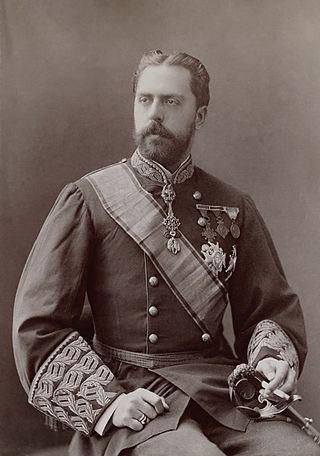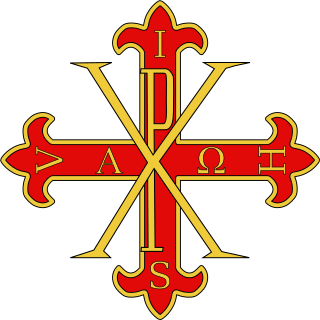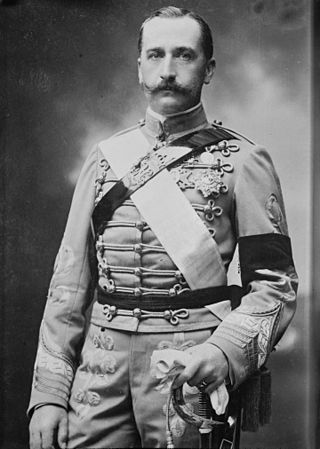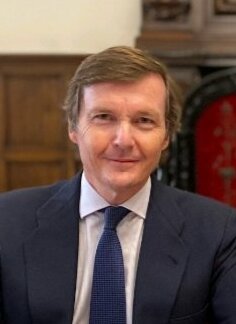
Francis I of the Two Sicilies was King of the Two Sicilies from 1825 to 1830 and regent of the Kingdom of Sicily from 1806 to 1814.
Infante, also anglicised as "infant" or translated as "prince", is the title and rank given in the Iberian kingdoms of Spain and Portugal to the sons and daughters (infantas) of the king, regardless of age, sometimes with the exception of the heir apparent or heir presumptive to the throne who usually bears a unique princely or ducal title. A woman married to a male infante was accorded the title of infanta if the marriage was dynastically approved, although since 1987 this is no longer automatically the case in Spain. Husbands of born infantas did not obtain the title of infante through marriage, although they were occasionally elevated to the title de gracia at the sovereign's command.

DonCarlos de Borbón y Austria-Este was the Carlist claimant to the throne of Spain from 1868, and holder of the Legitimist claim to the throne of France after the death of his father in 1887.

James Randolph Lindesay-Bethune, 16th Earl of Lindsay,, is a British businessman and Conservative politician.

Maria Isabella of Spain was Queen of the Two Sicilies from 4 January 1825 until 8 November 1830 as the wife of Francis I of the Two Sicilies.

DomSebastian Gabriel de Borbón y Braganza, Infante of Portugal and Spain, was an Iberian prince of the 19th century, progenitor of the Spanish ducal lines of Hernani, Ansola, Dúrcal and Marchena, and Carlist army commander in the First Carlist War.

Don Carlos María Alfonso Marcelo de Borbón-Dos Sicilias y Borbón-Parma, Infante of Spain, Duke of Calabria was, at his death, the last male infante of Spain during the reigns of his cousins King Juan Carlos I and King Felipe VI.

Infante Alfonso of Spain, Prince of the Two Sicilies, Duke of Calabria was one of two claimants to the title of the head of the House of Bourbon-Two Sicilies from 1960 until his death in 1964. Alfonso was the son of Prince Carlos of Bourbon-Two Sicilies (1870–1949) and his wife, María de las Mercedes, Princess of Asturias (1880–1904). He was born and died in Madrid, Spain.

The House of Bourbon-Two Sicilies is a cadet branch of the House of Bourbon that ruled Southern Italy and Sicily for more than a century in the 18th and 19th centuries. It descends from the Capetian dynasty in legitimate male line through Philip, Duke of Anjou, a younger grandson of Louis XIV of France (1638–1715) who established the Bourbon dynasty in Spain in 1700 as Philip V (1683–1746). In 1759, King Philip's younger grandson was appanaged with the kingdoms of Naples and Sicily, becoming Ferdinand IV and III (1751–1825), respectively, of those realms. His descendants occupied the joint throne, merged as the "Kingdom of the Two Sicilies" in 1816, until 1861, claimed it thereafter from exile, and constitute the extant Bourbon-Two Sicilies family.

The Sacred Military Constantinian Order of Saint George, also historically referred to as the Imperial Constantinian Order of Saint George and the Order of the Constantinian Angelic Knights of Saint George, is a dynastic order of knighthood of the House of Bourbon-Two Sicilies. Currently, the grand magistry of the order is disputed among the two claimants to the headship of the formerly reigning House of Bourbon-Two Sicilies as heirs of the House of Farnese, namely Prince Pedro and Prince Carlo. The order was one of the rare orders confirmed as a religious-military order in the papal bull Militantis Ecclesiae in 1718, owing to a notable success in liberating Christians in the Peloponnese. Together with the Sovereign Military Order of Malta, it is one of a small number of Catholic orders that still have this status today. It is not an order of chivalry under the patronage of the Holy See, but its membership is restricted to practising Catholics.

Prince Carlo of Bourbon-Two Sicilies, Duke of Castro is one of the two claimants to the headship of the former House of Bourbon-Two Sicilies.

Don Carlos, Prince of Bourbon-Two Sicilies, Infante of Spain was the son of Prince Alfonso of the Two Sicilies, Count of Caserta and his wife Princess Maria Antonietta of Bourbon-Two Sicilies, and nephew of the last King of the Two Sicilies, Francis II.

Princess Anne of Bourbon-Two Sicilies, Dowager Duchess of Calabria is the widow of Infante Carlos, Duke of Calabria. She is the third daughter and fifth child of Henri, Count of Paris, Orléanist claimant to the defunct French throne, and his wife Princess Isabelle of Orléans-Braganza.

Infante Luis, Count of Chinchón, known as the Cardinal Infante, was a Spanish infante and clergyman. He was a son of Philip V of Spain and his second wife, Elisabeth Farnese. He was cardinal deacon of the titular church of Santa Maria della Scala in Rome, archbishop of Toledo and as such primate of Spain.

Princess Alicia of Bourbon-Parma was a Spanish infanta. A member of the House of Bourbon-Parma, she became Duchess of Calabria through her marriage to Infante Alfonso, Duke of Calabria. She occasionally undertook official duties on behalf of the Spanish monarchy. Through marriage, she was the maternal half-aunt of King Juan Carlos I of Spain. She was the longest-lived Infanta of Spain.

Prince Pedro of Bourbon-Two Sicilies, Duke of Calabria, Grandee of Spain, is the only son of Infante Carlos, Duke of Calabria (1938–2015), and his wife, Princess Anne of Orléans. As primogeniture heir of the kings of the Two Sicilies he is the principal claimant to the headship of the Royal House of Bourbon-Two Sicilies, which ruled the Kingdom of the Two Sicilies before the unification of Italy.

Prince Gabriele of Bourbon-Two Sicilies was a prince of the deposed dynasty which ruled the Kingdom of the Two Sicilies.
The wedding of Juan Carlos, Prince of Asturias, and Princess Sofía of Greece and Denmark took place on Monday, 14 May 1962. The couple was married in three ceremonies: one according to the rites of the Roman Catholic Church, the groom's faith, at the Cathedral Basilica of St. Dionysius the Areopagite; one according to the rites of the Greek Orthodox Church, the bride's faith, at the Metropolitan Cathedral of Athens; and a third civil ceremony that was held upon their return to the Royal Palace. Don Juan Carlos was the eldest son of Infante Juan, Count of Barcelona, pretender to the Spanish throne, and Princess María de las Mercedes of Bourbon-Two Sicilies, while Princess Sofía was the eldest daughter of King Paul and Queen Frederica of Greece. Juan Carlos and Sofía were king and queen of Spain from 1975 until his abdication in 2014.

The wedding of Infanta Elena of Spain and Don Jaime de Marichalar y Sáenz de Tejada, Lord of Tejada, took place on Saturday, 18 March 1995 at Seville Cathedral in Seville, Andalusia.
















